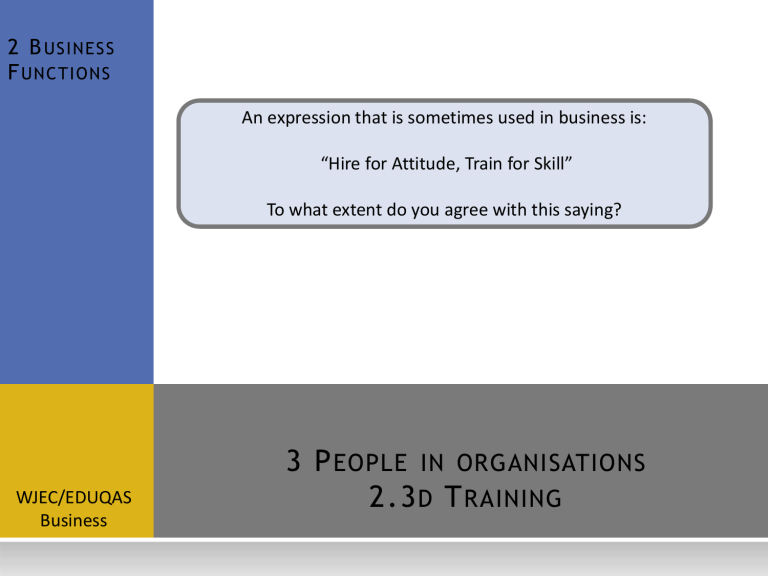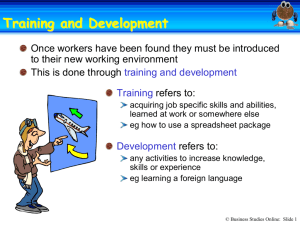
2 B USINES S F UNCTIONS An expression that is sometimes used in business is: “Hire for Attitude, Train for Skill” To what extent do you agree with this saying? WJEC/EDUQAS Business 3 P EOPLE IN ORGANISATIONS 2.3 D T RAINING 2.3 D T RAINING In this topic you will learn about Explain what is meant by training Explain the role of training in developing appropriate skills Explain the different methods of training including induction, on-the-job, off-the-job and apprenticeships Evaluate the importance and impact of training for a business and its stakeholder T RAINING Training is the process of equipping employees with the skills and knowledge necessary to carry out their job effectively Training can fulfil different roles within a business: Incentivise applicants to apply for a job Lead to internal promotions influencing the internal flow of workers Result in trained employees seeking alternative jobs elsewhere Training is essential to ensuring all employees have the skills necessary to carry out their day to day job roles effectively T RAINING Apprenticeships. Methods of training include: On-the–job where an employee learns in the workplace from experienced employees Off-the–job which is any form of education that takes place outside of the workplace Induction which is introductory training for employees new to an organisation Apprenticeships are schemes that allow young people to train and study in a workplace supported by experienced colleagues IN Complete the table below to show the possible advantages and disadvantages of on-the-job and off-the-job training Advantages On-the-job Should teacher training be provided on-thejob or off-thejob? PAIRS Off-the-job Disadvantages T RAINING AND STAKEHOLDERS How important are apprenticeships to the UK economy? How is the Government as a stakeholder affected by training? Business Employees Workforce who can meet customer needs Increased labour productivity Motivated workforce Adds to costs Equipped with the necessary skills to carry ut their jobs efficiently and safely Given confidence Feel valued and therefore motivated May be able to apply for promotions either internally or externally Community Educated and trained society Generally more happy, better paid, positive knock on effects T EST YOURSELF - 5 MINUTES 1. Distinguish between on-the-job and off-the-job training. 2. What is meant by induction training? 3. Explain how an apprenticeship can help an employee develop appropriate skills. End 2.3 D T RAINING In this topic you have learnt about Explain what is meant by training Explain the role of training in developing appropriate skills Explain the different methods of training including induction, on-the-job, off-the-job and apprenticeships Evaluate the importance and impact of training for a business and its stakeholder





